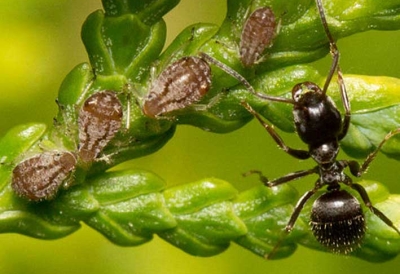Aphid control
Aphids are one of the most common insects found on trees and shrubs. In fact, there are over 350 species of aphid that occur in Colorado alone. Although this makes aphid control appear to be a daunting task, only a handful of these aphid species cause problems to plants. With all of the species of aphids to sort through, identifying which aphids are damaging to your plants is a task best left to the tree care service experts at SprayTech.
Aphids suck sap from plants. While a few will cause little to no damage, high population densities that remain untreated can cause the plant to start dying off. Wilting is common with aphid infestations. In addition to the damage they cause to plants, they also produce a sweet, sticky substance called “honeydew.” Honeydew is a sappy material that is generated by several phloem-sucking insects, including scales and aphids. The honeydew can cover entire leaves or branches, or just drop down onto benches and sidewalks below an infested tree. A sooty looking mold can start growing on the honeydew, which can reduce the aesthetic value of your trees. Furthermore, honeydew attracts other unwanted pests such as ants, wasps, flies and bees.
Aphids have a small, oval body with protrusions on their back. They rarely grow larger then 1/8inch. They can vary in color from pale yellow to black, green to orange or bright red. Woolly aphids cover themselves with a threadlike waxy coating, often associated with pines and conifers. Many species of aphid associate with specific plant species and morphological changes are different in all of them. Aphids are found in large colonies.
Signs of Attack

- Leaf curling: certain species of damaging aphids will settle on the underside of leaves. As they remove sap, the leaf curls around itself and can occasionally fall. Here’s the list of common aphids in Colorado including the ones causing leaf curling distortions.
- Honeydew: Finding that sweet, sticky sap on your car or favorite bench can be an indication of an aphid population (or other phloem-sucking insect) living in a tree above.
- Ants: Ants are attracted to the honeydew, along with other sap-eating insects.
Aphid Control & Prevention
Aphids have numerous natural predators. They have very little in terms of defense so they are easy food sources for ladybug larvae and lacewings. Flower flies are another common aphid control predator. There are also a few species of parasitic wasp that can infect aphids. These wasps insert their eggs into the aphid body and when they hatch they eat the aphid from the inside out. In certain areas, beneficial aphid control insects can be introduced to help manage aphid populations.
Another manual aphid control option is water. Smaller shrubs and plants can be sprayed with a high pressure water stream. This can kill the aphids on impact or force them onto the ground. It is difficult for the aphids to travel from the ground back onto the plant.
When natural or manual options for aphid management are not available, spraying for aphid control is a very useful treatment option. SprayTech has insecticidal soaps which are applied in a way that covers the aphid population entirely during application. Some options persist on the plant for a couple of days, ensuring that any remaining aphids are killed. We can also spray horticultural oils to help aphid control on stone fruits and other trees during the dormant season.
Don’t wait until your aphid population gets out of control. If you live in Denver, Castle Rock or Larkspur, request an estimate from the SprayTech team today!


